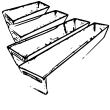
What is a level 5 finish?
The Gypsum Association, founded in 1930, is made up of some of the most well-known gypsum board manufacturers and retailers in North America. The Gypsum Association publishes much information for architects, builders, distributors and others on the subject of gypsum materials.
One such publication is known as GA-214-10. This publication outlines six levels of finish that specify the processes used to finish drywall. The Gypsum Association claims that this publication assists specifiers, owners, and contractors to precisely describe the desired finish of individual walls and ceilings to meet specific needs
.
If you want to read about drywall level finishes, you can download GA-214 here. Although the procedure of classifying drywall finishes by numbers 0-5 has been around since 1991, there is still some misunderstanding among tradesmen as to how to interpret these numbers. This article is not intended to describe each level in detail, for that you can read GA-214-10.
The numbers are rarely used in the field except for the popular level 5 finish, which has become somewhat of a buzzword used to refer to the highest quality smooth wall finish. Whenever someone needs the smoothest of smooth wall finishes they will ask for a level 5 finish.
In not-so-technical lingo, a level five finish refers to drywall that has been taped, first and second coated, and sanded lightly to remove tool marks. Then, a thin skim coat is spread across the entire surface including the seams and field. Once it dries, the skim coat is sanded lightly and checked with a halogen light to look for imperfections. The surface is then coated with a high-quality high-solids drywall primer before painting.
In recent years, gypsum manufacturers have developed products that can take the place of a skim coat. GA-214-10 refers to these materials as a suitable substitute for skim coating. However, they must be applied according to the manufacturers’ recommendations to qualify as a level-five finish. The USG Company recommends a process that replaces the second coat over seams with a spray-on product and after sanding recommends another product is used as the skim coat and primer all in one.
Why a skim coat is necessary
The first and second coat over seams and fasteners with drywall mud accomplishes the goal of leveling these areas to create an even surface. Therefore, what does the skim coat accomplish? Regardless of how skilled the tradesman is and how flat he makes the seams, there is still a difference in texture between the drywall paper and areas where mud has been applied. If painted without applying a skim coat, drywall seams may photograph (be visible) through the paint due to differences of texture.
By skimming the entire surface of the drywall with a very thin coat of drywall mud you press mud into the pores of the paper and fill any incidental imperfections in the field. Although most of the drywall mud applied when skimming is ultimately removed, the fact that mud was pressed into the pores of the paper ensures that the surface will be uniformly smooth across seams, drywall fasteners, and drywall paper.
When is a level 5 finish needed?
Some drywall tradesmen can use a level four finish (everything but the skim coat) to create a suitable smooth finish on walls. Ceilings that are finished smooth always require a level five finish. Any areas requiring high gloss paint must be finished using a level five finish.
In areas of critical lighting, a level-five finish is necessary even on vertical surfaces. Critical lighting includes areas where directional lighting hits a surface at less than a 45-degree angle. This is common where window lighting splashes across a wall that runs perpendicular to the window.
